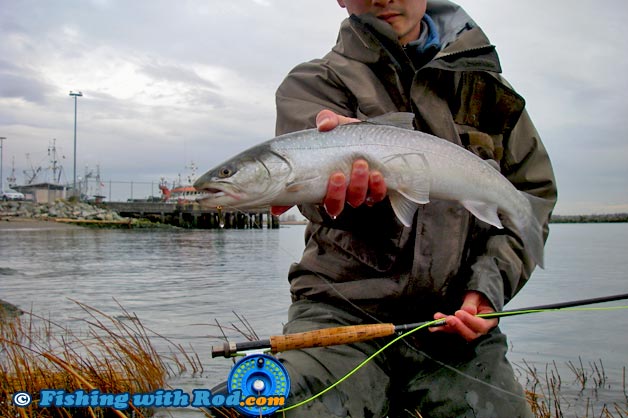Taking Your Own Hero Shots
By Rodney Hsu, Fishing with Rod | Published in December 2012

Whenever we catch a big or unique fish, most of us enjoy having a picture taken with it. If you are fishing alone, then this task becomes rather challenging. Do you hold the camera out with one hand, hold the fish with the other, attempt to pose while pressing the shutter button? Do you lean the camera on a rock or branch, put it on self timer and hope for the best when the shutter goes off?
More often than not, the outcome is not too desirable. The picture can be blurry, or a part of you or the fish can be outside the frame, or you may end up looking unhappy because you are focusing so much on getting the right picture. While it is difficult, capturing a reasonably good "hero shot" on your own certainly is not impossible. To accomplish this, there are several steps that I do with either a point and shoot or DSLR camera.

If your plan is to release the fish afterward, the very first thing to take note of, is to respect and ensure its welfare. The whole point is to capture a happy moment while letting the fish go afterward so it can live and reproduce. If the fish is accidentally killed during this process, then it completely defeats the whole purpose. Ideally, you should have a catch and release net with you so the fish can be kept in the net while fiddling with the camera settings. This is especially a must for a large fish. I like to submerge the entire net except the handle while setting up my camera so the fish is not stressed.
If you are unable to control your fish without damaging it while setting up the camera, then the best thing to do is to let it go immediately. You will always have more photo opportunities.
To capture a good photo of yourself with a fish without any help, you should carry a tripod. I personally prefer to carry a large, sturdy tripod for my DSLR camera but these can be quite heavy if your trip involves a lot of walking. A good alternative for a point and shoot camera is a small travel tripod with flexible legs such as a GorillaPod. The entire rig is usually small enough to fit in the pocket of your wading jacket or backpack. The only problem with a small tripod is that you cannot reach the height you want sometimes, but that can easily be solved by placing it on a big rock or thick branch at chest level.
Secondly, you should take advantage of the timer function in your camera. By delaying the shutter after the button is pressed, it allows you to handle your fish carefully so it would not be damaged. There is however, one problem with taking a single shot in timer mode. When the shutter button is pressed down, the camera is already focusing on a specific object (probably your hand as you reach the button). Once you hold the fish up and the shutter goes off, most likely you and the fish will not be in focus.

To avoid this problem, I like to use the multiple shot timer mode, so the camera will correct its focusing for each shot. The first shot is usually discarded, but the second, third, fourth shots should focus on you and the fish. Multiple shots also allow you to make errors as you adjust your pose. Quite often, only one or two out of five photographs turn out correctly.
If you are attempting this with a DSLR camera, then a remote control is required to achieve the correct focus. Personally, I prefer to choose the aperture mode and have the F value set at around 10, to give myself some room for errors. By decreasing the aperture size, I ensure that both myself and the fish which I am holding are both in focus.

Another problem that you should take into consideration is whether you and the fish are both in the frame or not. This simply takes some practice. You should be familiar with the focal lengths of your camera's lens. The last thing you want to do is to take a photo of your fish with your head missing, or a self portrait without your fish. Having a camera with a flip screen is advantageous, but be sure to look into the lens instead of the screen when the shutter goes off!

Taking a photograph of yourself with a fish is a little more complicated when you are alone, but it definitely can be done. With a tripod, some practice and a bit of patience, you can also capture that fishing memory and share it with your family and friends afterward.

